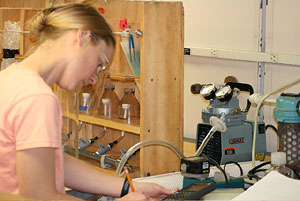

 | |||||||||||
|
|
Journals 2008/2009Jeff Lawrence
December 3, 2008 Scientists aboard the REVELLE brought a lot of equipment onboard and although some of it is rather sophisticated, modifications need to be made to accommodate the mission for that day. Below scientist Dave Drapeau is making his own incubator to test the effects of differing levels of carbon dioxide on the growth of coccolithophores. Coccolithophores take up "dissolved inorganic carbon" (which includes CO2, HCO3- and CO3--) out of the environment through photosynthesis and calcify an outer shell. This is significant because they are believed to be important in affecting CO2 levels in the atmosphere by transporting the CO2 to the bottoms on the oceans. While transecting the Patagonian Shelf, Dave will be collecting samples and adding differing levels of CO2 to see how rising levels of CO2 might affect coccolithphore development. Too much CO2 may make the oceans more acidic thereby impacting the development of the shell of the coccolithophores and inhibiting not only their growth, but also the removal of excess CO2 from our own atmosphere. Improvising is a valuable resource for scientist to have in the field. Much of the lab equipment used in the labs, were handmade by the scientist to accommodate their needs for collecting data.
While onboard I will be working with Heather Wright and Emily Lyczkowski using the fluorometer and FlowCam to determine what kind of biological life is living within the samples taken from the ocean. They will also be performing cell counts, the amount of chlorophyll in the water samples, and how much silica is in the diatoms. By knowing the chemistry and organics within a sample scientist can determine a lot about the overall makeup and interaction within that particular section of the ocean. The FlowCam determines the differing numbers and size of phytoplankton, giving you an overview of the community that live within that sample of ocean water. It will give a count of the number of biological species under 100 microns that are living within that sample and a microscopic picture of each kind of phytoplankton.
Montevideo is a beautiful area with moderate temperatures for this time of summer. With a cool breeze flowing in from the Atlantic temperatures are cooler than I expected at this latitude. Several showers have blown in off the ocean while I have been here, so it is a good idea to have rain gear ready when you venture out. Questions of the Day:
|
||||||||||

